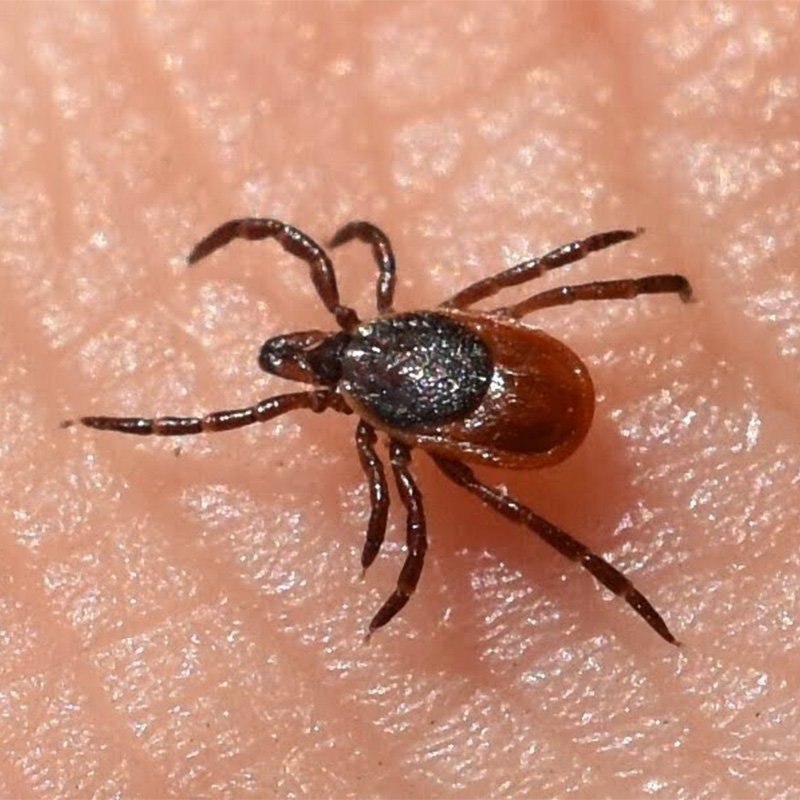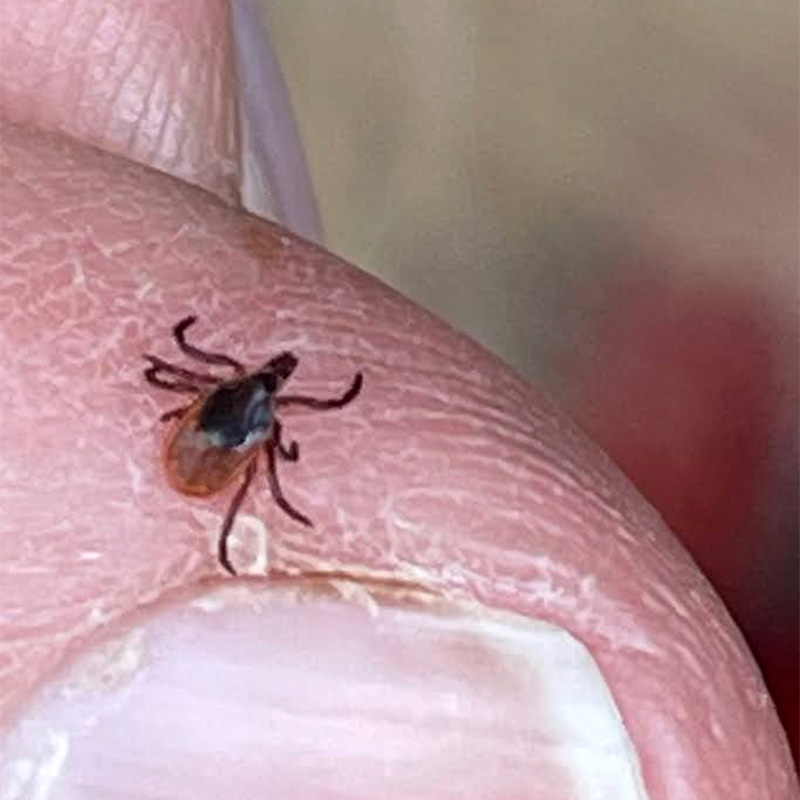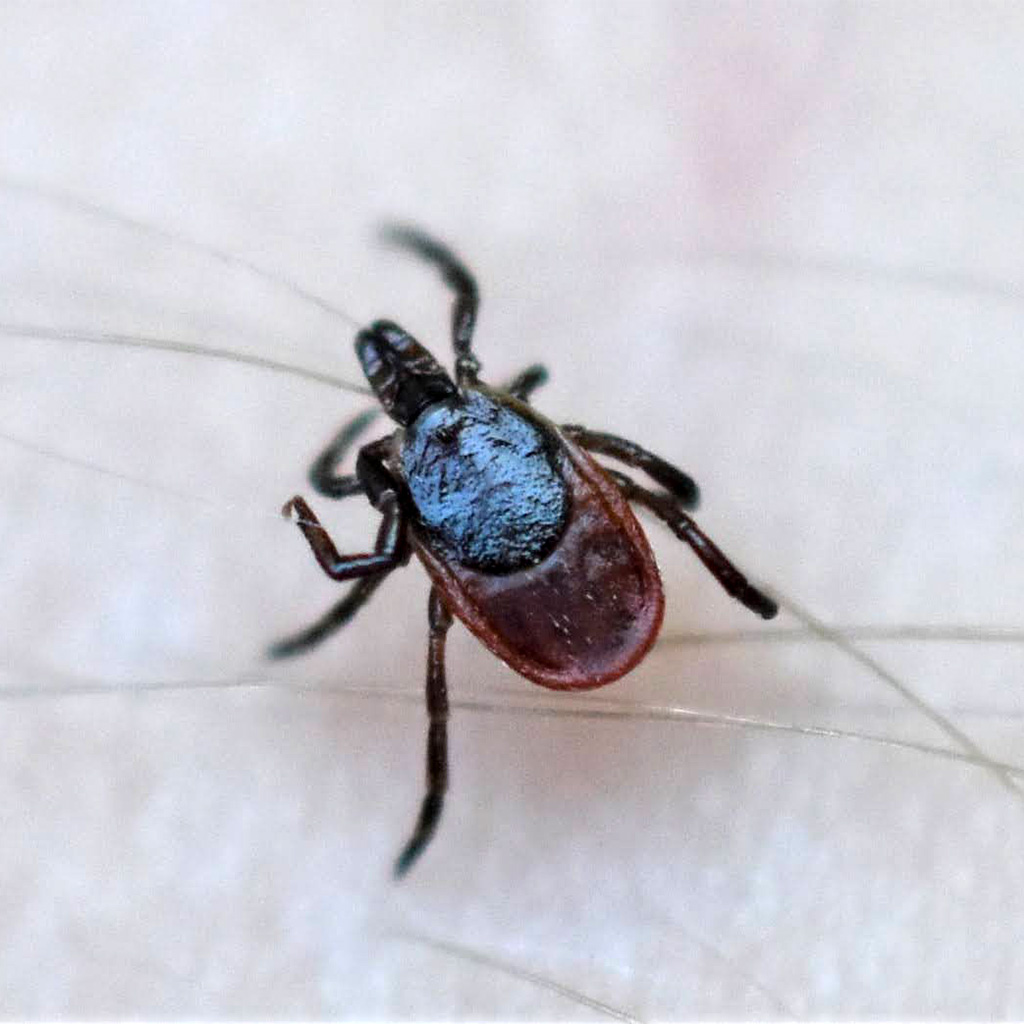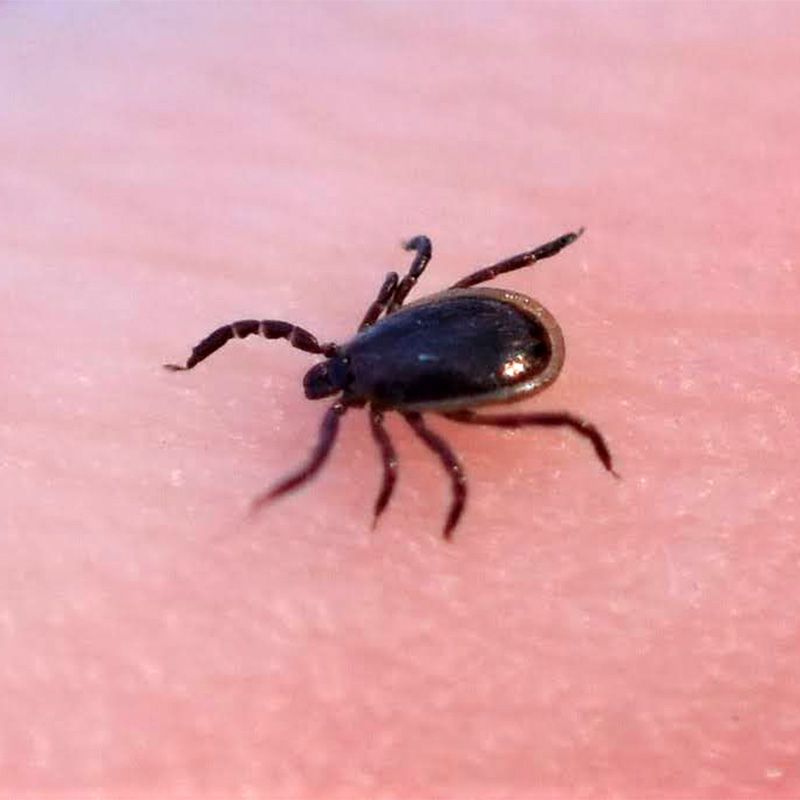The black-legged tick we hate and fear has a trick that could heal injuries and repair broken bones

Female deer ticks have red-brown bodies and black legs. (Photo: Robert Webster via Wikimedia Commons)
Ticks. The bane of a hiker’s existence. But did you know that the black-legged tick (Ixodes scapularis) or deer tick, as it is more commonly called, eats only three times in its life?
It’s true. In May, a female deer tick lays thousands of eggs, often in leaf litter. In the late summer, the eggs hatch into tiny six-legged larvae that crawl around the forest floor looking for a host. The larvae need their first meal to transform to the next stage of their life cycle. A white-footed mouse (one of the most abundant mammals in North America) often brushes against a larval tick. The tick grabs onto the mouse, where it finds its first blood meal. In our region, the white-footed mouse often carries Lyme-disease-causing bacteria on its skin. If a tick feeds on the mouse, it may become infected with the Lyme bacteria. The tick retains this bacterial infection for the rest of its life. From this point onward, the tick can transmit Lyme disease to other animals when it bites them. After the larvae finish feeding on their first host, they drop to the ground, where they molt into eight-legged nymphs in the fall.

In the northeast, more than 50 percent of adult female deer ticks may carry Lyme disease bacteria. (Photo: Ramóna Molnár)
Throughout the winter, the nymphs lie dormant under leaf litter and snow. In the warm spring and summer, they become active and search for their second blood meal, which often comes from a white-footed mouse, a white-tailed deer or even a human. If the nymph has been infected with Lyme disease, it can transmit the disease to its victim, or host. Once a nymph finds a host, it feeds for several days before dropping off to molt to its final stage – an adult tick. White-tailed deer are important sources of blood for ticks at this stage, and the deer help the ticks move to new areas.

Adult deer ticks are about the size of a sesame seed. (Photo: Robert D. Stevenson)
Adult ticks emerge in the fall. Male and female adults search for their third and final meal, often from white-tailed deer. The engorged females use this blood meal to produce eggs. Then female and male ticks mate, fertilizing the eggs. The male dies, but the female lies dormant over the winter and lays thousands of eggs in the spring. Then she, too, dies.
This tick life cycle lasts two to three years. To progress from larva to nymph, nymph to adult, and to lay eggs, a tick needs to eat a blood meal. During the last two stages (nymph and adult), ticks may feed on human blood.

Engorged deer ticks swell to twice their normal size. (Photo: National Institute of Allergy and Infectious Diseases via Wikimedia Commons)
An adult deer tick is most active from October to May. It rests on grass stalks and branches of low-lying shrubs about a meter off the ground. When a host brushes by, the tick grabs on. Ticks cannot fly or jump, so you have to touch them for them to crawl aboard. Nymphs are most active from April through July. Because nymphs are very small, very abundant and very difficult to see, most humans get Lyme disease from nymphs.

A male deer tick. Because of their larger shell, males cannot swell up as much as females when they feed. (Photo: Tom Murray)
White-footed mice run along forest floors searching for seeds, berries and bugs. They especially like to eat acorns in the fall. They are the primary carriers of Lyme disease bacteria. Studies have shown that a bountiful acorn harvest causes these mice to reproduce in greater numbers. Greater numbers of mice means that there are more hosts for deer ticks. This increase in deer ticks leads to an increase in human Lyme disease infections two years after a bountiful acorn season.

A deer tick near Blair Pond in Cambridge on Oct. 8, 2012. (Photo: Mark Rosenstein)
Studies have shown that ticks feeding on the white-footed mouse are more likely to survive than ticks that feed on other hosts. Therefore, the greater the number of mice, the greater the number of ticks that survive. Owls, hawks, foxes and other predators that eat white-footed mice do not get Lyme disease because the Lyme bacteria are killed by stomach acids. One of the best ways to control ticks and to protect human health is to control the white-footed mouse population. Natural predators do this quite nicely. It is therefore imperative that we do not poison owls and hawks so they can help keep mouse populations under control.

A deer tick in Hopkinton on May 15, 2022. (Photo: Ramóna Molnár)
How do ticks stay attached to a host for days and days without the host feeling them? The answer lies in tick spit. Ticks use hooked mouthparts to dig into and attach to a host’s skin, but this grip alone isn’t enough to stay attached for days. Tick saliva produces a special kind of cement that sticks their mouthparts to the skin tissue. The saliva also contains chemicals that suppress pain and itchiness. For this reason, a host often does not realize a tick is biting them. Scientists are studying tick spit because it might one day hold the key to making substances that can seal human injuries or repair bones.

Deer ticks are the only ticks in Massachusetts with black legs, so they are also called black-legged ticks. (Photo: Ramóna Molnár)
The Lyme disease bacteria in a tick’s gut do not activate until a tick latches on to a host. Then the bacteria make their way into the tick’s bloodstream and its salivary glands. It is only then that the bacteria can enter the host organism. For this reason, it takes a day or so before a person becomes infected with Lyme disease bacteria from a biting tick. If you check for and remove ticks immediately after walking through tick-prone areas, you can greatly reduce your risk of contracting this disease.
![]()
Seen nearby

Alex Handler was lucky enough to have his camera with him when he spotted this fisher in Harvard on May 21, 2021.
![]()
Have you taken photos of our urban wild things? Send your images to Cambridge Day, and we may use them as part of a future feature. Include the photographer’s name and the general location where the photo was taken.
Jeanine Farley is an educational writer who has lived in the Boston area for more than 30 years. She enjoys taking photos of our urban wild things.
This post was updated April 26, 2023, to correct the spelling of Jeffrey Offermann’s name.



nymphs are incredibly small. they look like specs of dirt until you try and brush them off. long sleeves, boots or pants in socks in boots. spray the hell out of wrists ankles and I wear a B-ball cap though I took it off once and found a tick in the crown of the interior. And now it is gardening season up north… ugh. am considering getting an old white sheet, and dragging it over the area I have to work and see what comes up.
Thanks for the tick article.
Yes, it would be good if the article included a link to info on how not to get bitten. In addition to Pete’s suggestions, I remove all my clothes when I come inside and put them in the dryer on low for 40 minutes, which dries out the ticks and kills them. I wear light colored clothes so it is easier to see any ticks.